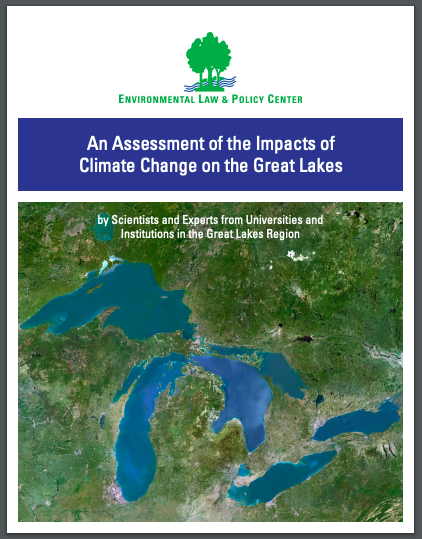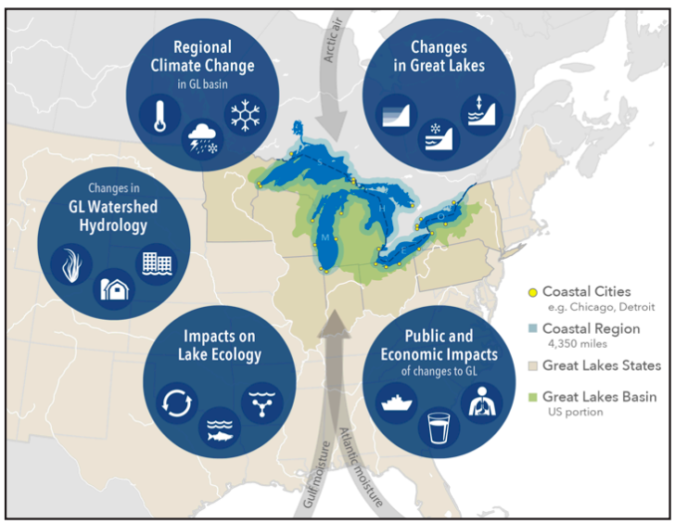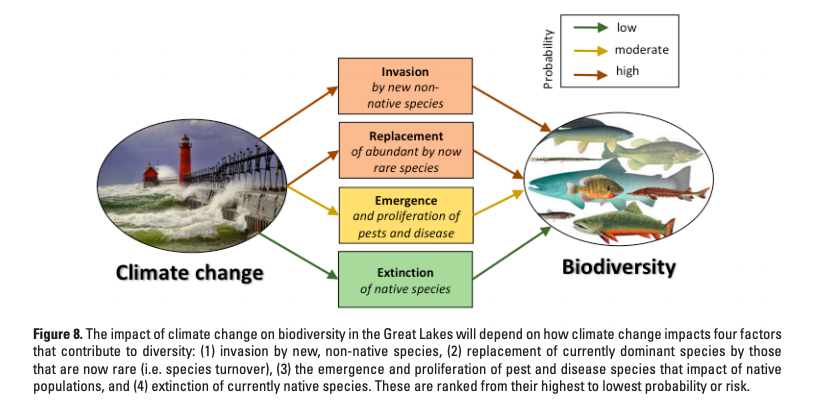ENVIRONMENTAL LAW & POLICY CENTER
Executive Summary
Introduction
 Climate change is causing significant and far-reaching impacts on the Great Lakes and the Great Lakes region. In recent years, our planet has experienced some of the warmest temperatures ever recorded, record-breaking weather extremes, powerful storms, increasing tragic flooding from rising sea levels and associated storm surge, huge wildfires, and continued melting of glaciers and polar sea ice. The accelerating pattern of changes in the Earth’s climate is affecting the Great Lakes. Here, we draw on the array of existing research to assess how the shifting global climate impacts the unique Great Lakes region.
Climate change is causing significant and far-reaching impacts on the Great Lakes and the Great Lakes region. In recent years, our planet has experienced some of the warmest temperatures ever recorded, record-breaking weather extremes, powerful storms, increasing tragic flooding from rising sea levels and associated storm surge, huge wildfires, and continued melting of glaciers and polar sea ice. The accelerating pattern of changes in the Earth’s climate is affecting the Great Lakes. Here, we draw on the array of existing research to assess how the shifting global climate impacts the unique Great Lakes region.
The Great Lakes have an enormous impact, seen and unseen, on the 34+ million people who live within its Basin. These millions of people rely on the freshwater lakes for drinking water, fisheries, recreation, and commerce and industry. The Great Lakes contain 5,500 cubic miles of freshwater, one of the very largest freshwater resources in the world. The Great Lakes support one of the world’s largest regional economies similar to those of whole developed nations. Agriculture, industrial manufacturing, fishing, and recreation together form an economic engine. Regional fisheries alone represent a $7 billion per year industry. Tourism generates $16 billion more.
Heavy human use over the past two centuries has taken its toll in the forms of habitat loss and fragmentation, influxes of invasive species, and polluted air, water, and sediments. Soil and nutrient runoff from agricultural fields and concentrated animal feedlot operations (CAFOs) imperil water quality and wildlife populations in many parts of the basin, threatening public and wildlife health and the economic vitality of the region. Climatic changes now underway further stress these ecosystems, alternatively raising and lowering lake levels and threatening the region in new ways.
The Great Lakes sustain remarkable populations of fish and habitats for wildlife. More than 170 species of fish live in the lakes, streams, rivers, and connecting waterways. Trout, sturgeon, walleye, lake whitefish and other varieties of fish are once again becoming plentiful among the five Great Lakes. The basin’s ecosystems support wolves and moose while providing resting and breeding grounds for large flocks of migratory birds and waterfowl. More than 3,500 species of plants and animals use its large network of streams, lakes, inland wetlands, coastal marshes and forests. Many of these species are rare or are found nowhere else.
The Great Lakes are large enough to themselves influence weather in the region. The Lakes moderate temperatures throughout the year, helping to cool nearby lands in the summer and warm them in winter. Their humidity feeds cloud cover and precipitation both over the lakes and downwind. That causes both “lake effect” snowstorms, and summer rainfall that provides ideal growing conditions for orchards in Michigan’s “fruit belt.”
Climate change presents challenges to the Great Lakes, with complicated effects and inter-relationships.
 Figure 1. A schematic diagram highlighting the focus areas and themes of the assessment and the major pathways.
Figure 1. A schematic diagram highlighting the focus areas and themes of the assessment and the major pathways.
Air Temperature Increases
The Great Lakes region has tracked global increases in temperature and outpaced trends in some parts of the contiguous United States. Between 1901-1960 and 1985- 2016, the Great Lakes basin has warmed 1.6°F in annual mean temperature, exceeding average changes of 1.2°F for the rest of the contiguous United States. By the end of the 21st century, global average temperatures are expected to rise an additional 2.7°F to 7.2°F, depending on future greenhouse gas emissions, with corresponding changes in the Great Lakes region.
Heavy Precipitation and Flooding
A warmer atmosphere holds more moisture, increasing the frequency and intensity of heavy rain and snow events. Overall U.S. annual precipitation increased 4% between 1901 and 2015, but the Great Lakes region saw an almost 10% increase over this interval with more of this precipitation coming as unusually large events. In the future, precipitation will likely redistribute across the seasons. We expect wetter winters and springs, while summer precipitation should decrease by 5-15% for most of Great Lake states by 2100.
These increases in precipitation will likely increase flooding across the Great Lakes region. In cities with abundant roofs, concrete, and other impermeable surfaces, this will likely damage homes, roadways, and other infrastructure. In rural areas, intense rains and melting snows will increase runoff and erode soils. In rural areas, increased flooding will also cause soil erosion. In combination with more unpredictable precipitation and warmer temperatures, these effects could seriously curtail Midwestern agricultural production.
Extreme Weather
Climate change is causing more extreme weather across the United States. Heat waves have become more common since the 1960s while extreme cold temperatures have generally decreased. Intense summer storms occur more often as temperatures rise.
Extreme weather events have already taken their toll on the Midwest. The 2012 Midwestern heat wave and drought caused more than $30 billion in economic damage, 123 deaths, and harmful long-term health impacts across most of the central and western United States.
Extremely warm days (above 90°F) will increase for states bordering the Great Lakes, especially in the southern parts of the region. By century’s end, the region will experience 30 to 60 additional days each year of these extremely warm temperatures. Areas within the Great Lakes Basin will see an increase of 17 to 40 extremely warm days as annual average temperatures continue to rise.
Meanwhile, in states surrounding the Great Lakes, the number of extremely cold days (with temperature less than 32°F) will decrease significantly. Lake effect snowfalls could be even more dramatic, particularly across the Lake Ontario snowbelt in upper western areas of New York state where three- and four-feet snowstorms are already routine.
Agriculture, Irrigation, and Decreased Crop Yields
Changes in seasonal precipitation are already affecting farmers in Midwestern states, with planting delays caused by spring flooding and excessively wet soil conditions. Delayed planting puts crops at greater risk during hotter and drier conditions later in the growing season, and that increases the demand for irrigation to mitigate crop losses. Hot temperatures interfere with pollination in corn and other crops, thereby reducing yields.
Yet, even with increased water management in agricultural watersheds, climate change will likely reduce crop yields for both soybean and maize by 10% – 30% by mid-century in the southern parts of the Great Lakes watershed. Soybean and maize production will likely move northward.
Urban Issues
In the summer, high temperatures and heat waves cause poorer air quality, which harms public health, especially for the most vulnerable people – the elderly and children with asthma. For the many millions of people living in urban areas across the Great Lakes states, heat waves and summer air pollution events increase the risk for heat-related illness, respiratory diseases, and death.
Projected increases in extreme precipitation will likely exacerbate flooding, especially in winter, spring, and during summer thunderstorms. Extreme winter rain events in 2017 and 2018 led to serious flooding. Rain events exceeding 6 inches now occur regularly, exceeding the capacity of culverts and storm sewers to handle runoff. Under-resourced communities in low-lying, flood-prone areas have become vulnerable to infrastructure damage, transportation barriers, and displacement from homes due to these intensified floods.
Water Quality and Consumption
Climate change will likely threaten drinking water quality and place great stress on water infrastructure. For example, in southern Wisconsin, extreme precipitation could rise by 10% to 40%, overloading water treatment infrastructure, increasing sewer overflows, and increasing the quantity of water-born pathogens flowing into streams, rivers, and Lake Michigan.
The Great Lakes have higher levels of E. coli bacteria than other U.S. coastal regions. This untreated effluent is a public health hazard and economically costly to mitigate. Cities like Chicago have spent enormous sums to protect against water pollution. Nutrients (primarily nitrogen and phosphorous) run off from farms into surface waters during intense rain events. These excess nutrients threaten human health both directly (e.g., “blue baby” syndrome) and indirectly by contributing to toxic harmful algal blooms in shallow water bays of the Great Lakes and the “dead zone” in the Gulf of Mexico that has decimated shellfisheries.
In 2011, Lake Erie experienced the largest harmful algal bloom in its recorded history, with peak intensity more than three times greater than any previously observed blooms. In 2014, 500,000 people in the Toledo area were without safe local drinking water supplies for 72 hours because of toxic algae blooms in western Lake Erie. Algal blooms will likely become more frequent in the future as higher temperatures and heavy precipitation mix heavy nutrient loads with warmer waters. These pollutants have dramatically raised the cost of water treatment.
Lake Ecology
Climate change has already increased bacteria levels in the Great Lakes, as the water warms earlier in the spring and warming contributes to vertical mixing that changes lake ecosystems. Sewer overflows, the dumping of ship ballast water, and nutrient runoff from agriculture and industry all contribute to growth of bacteria and several invasive species in the lakes. Heavier rainstorms and warmer weather exacerbate these challenges.
Hundreds of new species of pathogenic bacteria, viruses, protozoa, and non-native species could be introduced and flourish in the warming conditions, displacing local native species. While climate change may not directly drive lake species extinct, the persistence of many native species will be threatened as they confront more invasive species, species replacements, and proliferating pest and disease organisms.
Download full version (PDF): An Assessment of the Impacts of Climate Change on the Great Lakes
Download (PDF): Policy Recommendations
About the Environmental Law & Policy Center
http://elpc.org/
The Environmental Law & Policy Center of the Midwest is a leading public interest environmental legal advocacy and eco-business innovation organization. We develop and lead successful strategic advocacy campaigns to improve environmental quality and protect our natural resources.
.
Tags: ecosystems, Environmental Law & Policy Center, extreme weather, Freshwater, Great Lakes, Great Lakes Basin, Lake Erie, Lake Huron, Lake Michigan, Lake Ontario, Lake Superior, wildlife







 RSS Feed
RSS Feed
Dear sirs, Bipartisain ballast water legislation was signed into law by President Trump in December 2018. Reportedly the EPA is to work with the Great Lakes States. Land based infrastructure for ballast water problems would be beneficial. Many on board technologies for ballast water may not have the functionality to address multiple invasive issues.The regulations being formulated for ships using the Great Lakes is reportedly suppose to be completed after the 2020 election.
Algae blooms are becoming more problematic in the Great Lakes. Johns Hopkins has confirmed an algal virus found in green algae throughout the Great Lakes has jumped species to humans causing cognitive problems. Mosquitoes that carry disease thrive on algae. Ballast water disperses existing algae throughout the Great Lakes. Virus’s coming from ocean water can lie dormant in sediment. Salt water virus has been known to mutate to fresh water.
There is no broadcast media coverage. Now more than ever is when environmentalist should be reaching out. Sadly even on the web there is a strange silence. Those who care should let their politicians know.